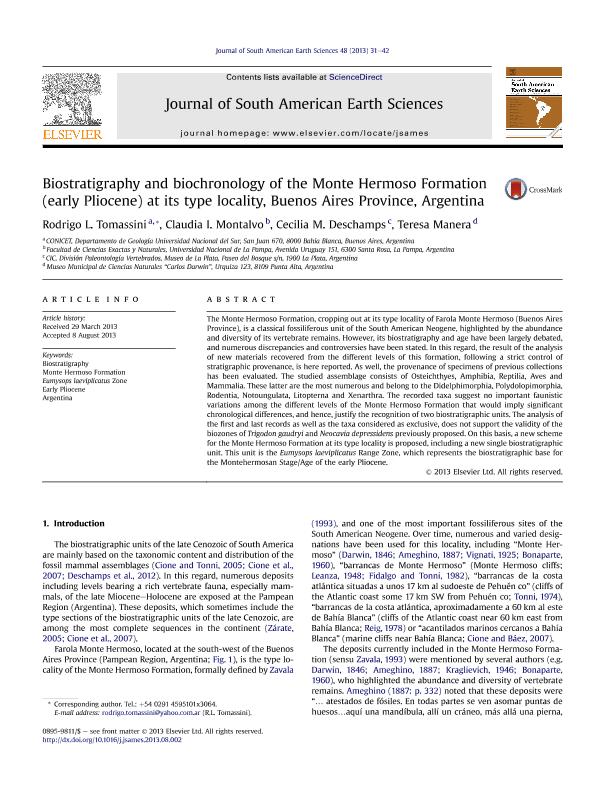Mostrar el registro sencillo del ítem
dc.contributor.author
Tomassini, Rodrigo Leandro

dc.contributor.author
Montalvo, Claudia Inés

dc.contributor.author
Deschamps, Cecilia Marcela

dc.contributor.author
Manera, Teresa

dc.date.available
2017-07-28T20:58:36Z
dc.date.issued
2013-12
dc.identifier.citation
Tomassini, Rodrigo Leandro; Montalvo, Claudia Inés; Deschamps, Cecilia Marcela; Manera, Teresa; Biostratigraphy and biochronology of the Monte Hermoso Formation (early Pliocene) at its type locality, Buenos Aires Province, Argentina; Elsevier; Journal of South American Earth Sciences; 48; 12-2013; 31-42
dc.identifier.issn
0895-9811
dc.identifier.uri
http://hdl.handle.net/11336/21606
dc.description.abstract
The Monte Hermoso Formation, cropping out at its type locality of Farola Monte Hermoso (Buenos Aires Province), is a classical fossiliferous unit of the South American Neogene, highlighted by the abundance and diversity of its vertebrate remains. However, its biostratigraphy and age have been largely debated, and numerous discrepancies and controversies have been stated. In this regard, the result of the analysis of new materials recovered from the different levels of this formation, following a strict control of stratigraphic provenance, is here reported. As well, the provenance of specimens of previous collections has been evaluated. The studied assemblage consists of Osteichthyes, Amphibia, Reptilia, Aves and Mammalia. These latter are the most numerous and belong to the Didelphimorphia, Polydolopimorphia, Rodentia, Notoungulata, Litopterna and Xenarthra. The recorded taxa suggest no important faunistic variations among the different levels of the Monte Hermoso Formation that would imply significant chronological differences, and hence, justify the recognition of two biostratigraphic units. The analysis of the first and last records as well as the taxa considered as exclusive, does not support the validity of the biozones of Trigodon gaudryi and Neocavia depressidens previously proposed. On this basis, a new scheme for the Monte Hermoso Formation at its type locality is proposed, including a new single biostratigraphic unit. This unit is the Eumysops laeviplicatus Range Zone, which represents the biostratigraphic base for the Montehermosan Stage/Age of the early Pliocene.
dc.format
application/pdf
dc.language.iso
eng
dc.publisher
Elsevier

dc.rights
info:eu-repo/semantics/openAccess
dc.rights.uri
https://creativecommons.org/licenses/by-nc-sa/2.5/ar/
dc.subject
Biostratigraphy
dc.subject
Monte Hermoso Formation
dc.subject
Eumysops Laeviplicatus Zone
dc.subject
Early Pliocene
dc.subject
Argentina
dc.subject.classification
Paleontología

dc.subject.classification
Ciencias de la Tierra y relacionadas con el Medio Ambiente

dc.subject.classification
CIENCIAS NATURALES Y EXACTAS

dc.title
Biostratigraphy and biochronology of the Monte Hermoso Formation (early Pliocene) at its type locality, Buenos Aires Province, Argentina
dc.type
info:eu-repo/semantics/article
dc.type
info:ar-repo/semantics/artículo
dc.type
info:eu-repo/semantics/publishedVersion
dc.date.updated
2017-07-28T17:52:47Z
dc.journal.volume
48
dc.journal.pagination
31-42
dc.journal.pais
Países Bajos

dc.journal.ciudad
Ámsterdam
dc.description.fil
Fil: Tomassini, Rodrigo Leandro. Universidad Nacional del Sur. Departamento de Geología; Argentina. Consejo Nacional de Investigaciones Científicas y Técnicas; Argentina
dc.description.fil
Fil: Montalvo, Claudia Inés. Universidad Nacional de La Pampa. Facultad de Ciencias Exactas y Naturales; Argentina
dc.description.fil
Fil: Deschamps, Cecilia Marcela. Universidad Nacional de la Plata. Facultad de Ciencias Naturales y Museo. División Paleontología Vertebrados; Argentina. Provincia de Buenos Aires. Gobernación. Comisión de Investigaciones Científicas; Argentina
dc.description.fil
Fil: Manera, Teresa. Provincia de Buenos Aires. Museo Municipal de Ciencias Naturales “Carlos Darwin”; Argentina
dc.journal.title
Journal of South American Earth Sciences

dc.relation.alternativeid
info:eu-repo/semantics/altIdentifier/doi/http://dx.doi.org/10.1016/j.jsames.2013.08.002
dc.relation.alternativeid
info:eu-repo/semantics/altIdentifier/url/http://www.sciencedirect.com/science/article/pii/S0895981113001168
Archivos asociados
